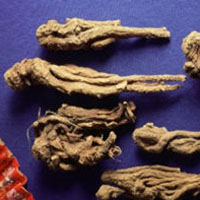Search Healthnotes
Dong Quai
 © Steven Foster
© Steven FosterParts Used & Where Grown
Dong quai is a member of the celery family. Greenish-white flowers bloom from May to August, and the plant is typically found growing in damp mountain ravines, meadows, river banks, and coastal areas. The root is used in herbal medicine.
- Reliable and relatively consistent scientific data showing a substantial health benefit.
- Contradictory, insufficient, or preliminary studies suggesting a health benefit or minimal health benefit.
- For an herb, supported by traditional use but minimal or no scientific evidence. For a supplement, little scientific support.
Our proprietary “Star-Rating” system was developed to help you easily understand the amount of scientific support behind each supplement in relation to a specific health condition. While there is no way to predict whether a vitamin, mineral, or herb will successfully treat or prevent associated health conditions, our unique ratings tell you how well these supplements are understood by the medical community, and whether studies have found them to be effective for other people.
For over a decade, our team has combed through thousands of research articles published in reputable journals. To help you make educated decisions, and to better understand controversial or confusing supplements, our medical experts have digested the science into these three easy-to-follow ratings. We hope this provides you with a helpful resource to make informed decisions towards your health and well-being.
This supplement has been used in connection with the following health conditions:
| Used for | Amount | Why |
|---|---|---|
Dysmenorrhea | Refer to label instructions | Dong quai has been used either alone or in combination with other traditional Chinese medicine herbs to help relieve painful menstrual cramps. |
Menopause | Refer to label instructions | Dong quai is an herb with weak estrogen-like actions similar to soy. In one trial, a formula containing licorice, burdock, dong quai, wild yam, and motherwort reduced menopause symptoms. |
Premenstrual Syndrome | Refer to label instructions | In Traditional Chinese medicine, dong quai is typically used in combination with herbs such as peony and osha for menopausal symptoms and menstrual cramps. |
Traditional Use (May Not Be Supported by Scientific Studies)
Also known as dang-gui in Traditional Chinese Medicine (TCM), dong quai is sometimes referred to as the female ginseng. In Traditional Chinese Medicine, dong quai is often included in herbal combinations for abnormal menstruation, suppressed menstrual flow, dysmenorrhea (painful menstruation), and uterine bleeding. It is not used in TCM for treating symptoms associated with menopause, such as hot flashes. It is also used in TCM for both men and women with cardiovascular disease, including high blood pressure and problems with peripheral circulation.1
Copyright © 2026 TraceGains, Inc. All rights reserved.
Learn more about TraceGains, the company.
The information presented by TraceGains is for informational purposes only. It is based on scientific studies (human, animal, or in vitro), clinical experience, or traditional usage as cited in each article. The results reported may not necessarily occur in all individuals. Self-treatment is not recommended for life-threatening conditions that require medical treatment under a doctor's care. For many of the conditions discussed, treatment with prescription or over the counter medication is also available. Consult your doctor, practitioner, and/or pharmacist for any health problem and before using any supplements or before making any changes in prescribed medications. Information expires December 2026.











